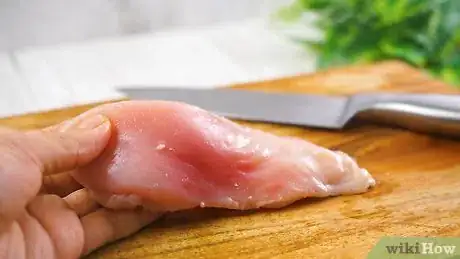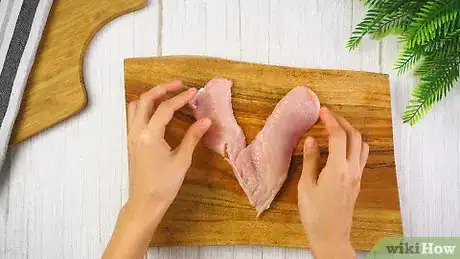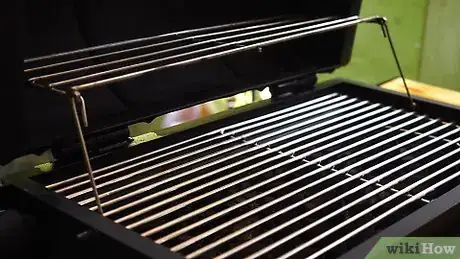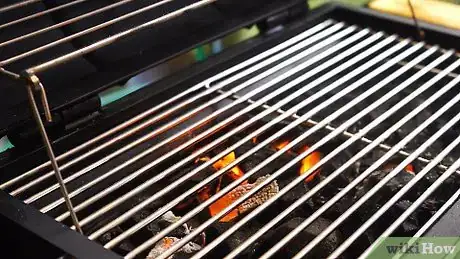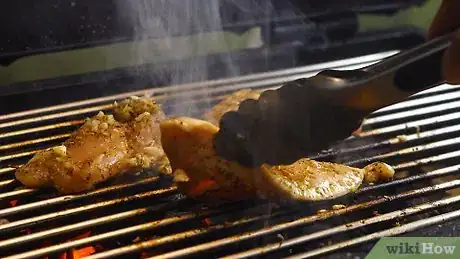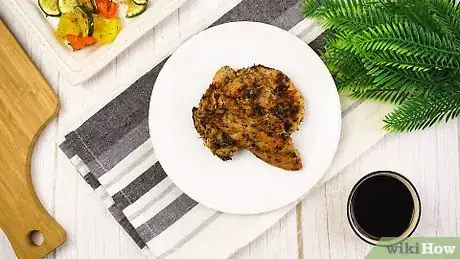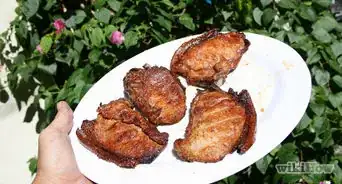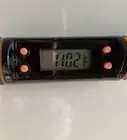This article was co-authored by Jillian Fae Downing. Jillian Fae Downing is a Private Event Chef, Chef Educator, and the Owner of Jillian Fae Chef Services based out of Temecula, California. With 12 years of experience, she specializes in menu planning and menu research and development. Jillian Fae holds an Associate of Science in Culinary Arts from Orange Coast College and a BA in Mass Communication and Media Studies from Arizona State University. She is also a member of the American Culinary Federation and the American Personal and Private Chef Association.
There are 7 references cited in this article, which can be found at the bottom of the page.
This article has been viewed 110,623 times.
Grilling chicken is quick and easy, but there are a few tricks you can do to get it done just right. Unlike beef, chicken must be cooked all the way, or you risk getting very, very sick. This article will show you how to properly, and safely, prepare chicken.
Steps
Preparing and Seasoning the Chicken
-
1Prepare the chicken pieces. Wash your hands with soap and warm water. Use a knife to trim off any skin and/or excess fat. Wash the chicken pieces using cold water, and pat them dry with a paper towel.
- If the chicken pieces, such as wings, thighs, and legs, still have the bone in them, consider leaving the skin on.
- Take the chicken out of the fridge and let it rest for about 20 minutes on the counter so that it can come up to room temperature. This will reduce the thermal shock, and the chicken will be less likely to dry out during the cooking.
- If you need to defrost the chicken, do so in the fridge or in the microwave. Do not defrost chicken at room temperature.
-
2Pound boneless chicken breasts flat until they are about ¾ inches (1.91 centimeters) thick. Place the chicken breasts inside a plastic, re-sealable freezer bag. Seal the bag, then whack the chicken with a rolling pin or meat pounder. The bag will keep the juices from splattering all over your kitchen. When you are done, take the chicken breasts out of the bag and rinse them.[1]
- Pounding the chicken breasts flat ensures that they cook evenly.
Advertisement -
3Consider butterflying a whole chicken to cut down on cooking time. Butterflying the chicken involved taking out the backbone and breastbone. This will allow the chicken to lie flat on the grill, and speed up the cooking process. To butterfly a chicken, do the following:
- Cut off the neck and remove the giblets.
- Place the chicken breast-side-down and cut down both sides of the backbone. Pull out the backbone and discard it.
- Pull open the chicken, like a book.
- Cut away the breastbone, then pull it out. Discard the bone.
-
4Consider marinating chicken breasts in the fridge for 4 to 12 hours. Combine all of the ingredients for your marinade in a plastic, re-sealable bag. Add the chicken, seal the bag, and leave it in the fridge for 4 to 12 hours. For a classic lemon and herb marinade for four chicken breasts, you will need:[2]
- 6 tablespoons extra virgin olive oil
- 4 large garlic cloves, minced
- 1 teaspoon dried thyme
- 1½ teaspoons lemon zest, from one lemon
- 1 ¼ teaspoon salt
- ½ teaspoon dried oregano
- ½ teaspoon freshly ground black pepper
-
5Consider using a rub on chicken legs and thighs. You can put the rub onto the chicken just before you grill it, or let it marinate for one hour. Simply mix your rub together, and pat it into the chicken. For a simple rub, you will need:[3]
- 4 teaspoons kosher salt
- 2 teaspoons ground cumin
- 2 teaspoons chili powder
- 2 teaspoons dried cilantro
- 2 teaspoons dried onion flakes
-
6Consider brining the chicken for 2 to 3 hours in ¼ cup (25 grams) salt and 4 cups (950 milliliters) water. Combine the salt and water in a large pot, then add the chicken breasts. Unlike with marinating, the longer you brine is not better. Leave the chicken in the brine for only 2 to 3 hours; any longer, and the chicken will turn rubbery.[4]
- You can also add ⅛ cup of sugar or some other sweetener, like honey, agave syrup, or maple syrup if you are looking for that flavor element.
- Start with a small amount of hot water to dissolve your salt and sweetener. Then you can add ice until it gets to your desired ratio to cool it down quicker, because you don't want to put raw chicken in hot water.
Grilling the Chicken
-
1Make sure that the grill is clean. Chicken is more likely to stick to a dirty grill than to a clean one. If you have not yet already done so, get out that grill brush, and scrub the grate clean.
-
2Start up the grill. If you are cooking bone-in or different cuts of chicken, consider having a two-zone fire. This means one half of the grill will be very hot while the other half will be less hot. The hot part will have "direct heat," and the less-hot part will have "indirect heat." You can do this by piling the coal on one side of the grill (for a charcoal grill), or turning up the flames on one side (for a gas grill).
- For breasts and wings, use a direct medium heat, about 350°F (176°C).
- For legs and bone-in thighs, use indirect, medium heat.
- For boneless thighs, use direct, high heat 450 - 650° F.
- For whole chicken and bone-in chicken (breasts, legs, and thighs), use indirect medium heat.
-
3Oil the grill by wiping it down with an oily brush or paper towel. Chicken is more likely to stick to a dirty grill. Oiling it will protect the chicken from sticking.[5]
-
4Place the chicken on the grill and replace the grill cover. If you are using a two-zone fire, make sure that you are placing the boneless pieces over direct heat, and the bone-in pieces over indirect heat. The one exception to this rule are chicken wings, which should be placed over direct heat.
-
5Consider searing bone-in chicken pieces if you are using a two-zone fire. Place the bone-in pieces to the hottest part of the grill, and cook them over direct heat for 3 to 4 minutes, turning once. When you are done, transfer them to the cooler part of the grill, so that they can finish cooking over indirect heat. This will give the pieces that nice, crunchy texture on the outside.
-
6Grill the chicken, covered, until it is done. Covering the grill is very important, because it traps the heat and helps the chicken retain moisture. Listed below are the different cuts of chicken and the recommended cooking times. Keep in mind, however, that the times may vary, depending on the weather, the grill you are using, and how large/thick the chicken pieces are.
- Cook chicken breast for 8 to 12 minutes, turning once. Thinner pieces, such as cutlets, will need 2 to 3 minutes.
- Cook boneless chicken thighs for 8 to 10 minutes, turning once.
- Cook chicken wings for 18 to 20 minutes, turning once.
- Cook a whole chicken for 1 ½ to 2 hours (3 ½ to 4 ½ pounds), 40 minutes if you butterflied it.[6]
- Cook bone-in pieces (breasts, legs, and thighs) for 30 to 40 minutes, turning occasionally. Larger pieces may require up to 50 minutes.
-
7Consider adding a glaze or barbeque sauce in the last 10 minutes of grilling. Brush some glaze or sauce over the pieces, and grill them for 5 minutes, covered. Turn the pieces over, brush on more glaze or sauce. Cover the grill, and cook for another 5 minutes.[7]
- If you plan on using some of the sauce for dipping/serving later on, set aside however much you need before you brush the sauce onto the chicken. This will prevent any cross-contamination.[8]
Finishing and Serving
-
1Test for doneness. Unlike steak, chicken must be fully cooked, and cannot be eaten rare. There are two ways you can check chicken for doneness:
- Stick a meat thermometer into the chicken. This is the most reliable way to avoid undercooking or overcooking. The chicken is done if the temperature reads at least 165°F (74°C) for boneless pieces, and 180°F (82°C) for bone-in pieces.
- Cut one of the chicken pieces open. The meat should be opaque, and the juices should run clear.
-
2Remove the chicken from heat and let it rest for 5 minutes before serving. This resting period will allow the juices to sink into the meat, making it even juicier. Keep the chicken breasts warm, about 140°F (60°C) while they rest. You can do this by placing them on a plate and covering them, or transferring them to a warm, flameless part of the grill.
-
3Consider serving the chicken with some sauce or glaze. If you have any sauce or glaze leftover from grilling, consider pouring it into a dish, and serving it alongside the chicken. Just make sure that none of the sauce came in contact with the raw chicken.
-
4Remember to wash everything that came in contact with raw chicken before using it again. If you have not already done so, wash all of your knives, brushes, and cutting boards using hot water and soap. This is vital, especially if you plan on using these utensils again to serve the chicken.
Warnings
- Always wash all surfaces and utensils used to prepare raw chicken with soap and hot water.⧼thumbs_response⧽
- Always test chicken for doneness. Never serve chicken rare or undercooked.⧼thumbs_response⧽
- Never thaw chicken at room-temperature. Thaw it either in the microwave or in the fridge.⧼thumbs_response⧽
- Never marinate chicken outside the fridge.⧼thumbs_response⧽
Things You'll Need
- Cutting board
- Sharp knife
- Grill
- Marinades or seasoning (optional)
- Brush (for oil and glaze)
- Grill thongs
- Meat thermometer (recommended)
References
- ↑ http://www.seriouseats.com/2012/06/hot-to-grill-boneless-skinless-chicken-breast.html
- ↑ http://www.onceuponachef.com/2010/06/perfectly-grilled-chicken-breasts.html
- ↑ http://www.food.com/recipe/easy-southwestern-grilled-chicken-rub-and-marinade-212033
- ↑ https://www.kingsford.com/how-to/boneless-skinless-chicken-breasts/
- ↑ https://www.thekitchn.com/10-tips-for-perfect-grilled-chicken-220947
- ↑ http://www.rachaelraymag.com/food-how-to/cooking-tips/how-to-grill-chicken
- ↑ https://www.kingsford.com/how-to/bone-in-chicken-pieces
- ↑ https://www.thekitchn.com/10-tips-for-perfect-grilled-chicken-220947
About This Article
To grill chicken breasts, first wrap them in plastic wrap and place them on a cutting board. Pound the chicken with a tenderizer until it’s uniformly thick so it cooks evenly. Then, season the chicken with salt, pepper, and your favorite seasonings, like garlic powder, cumin, or chili powder. Brush olive oil over the grates on your grill using a paper towel, then pre-heat the grill to medium. Set the chicken breasts directly on the heat and cook them for 8-12 minutes per side or until they're golden brown. To grill chicken thighs, season them as you would chicken breasts, but preheat your grill to high heat. Place the thighs on the grill and cook them for 6-8 minutes on each side or until the thighs are golden brown. You can check the temperature of grilled chicken with an instant-read thermometer to see if it's done. When the internal temperature is at least 165°F (74°C), it’s ready to be served. If you want to learn how to add a marinade or seasoning to your chicken while you grill it, keep reading!
